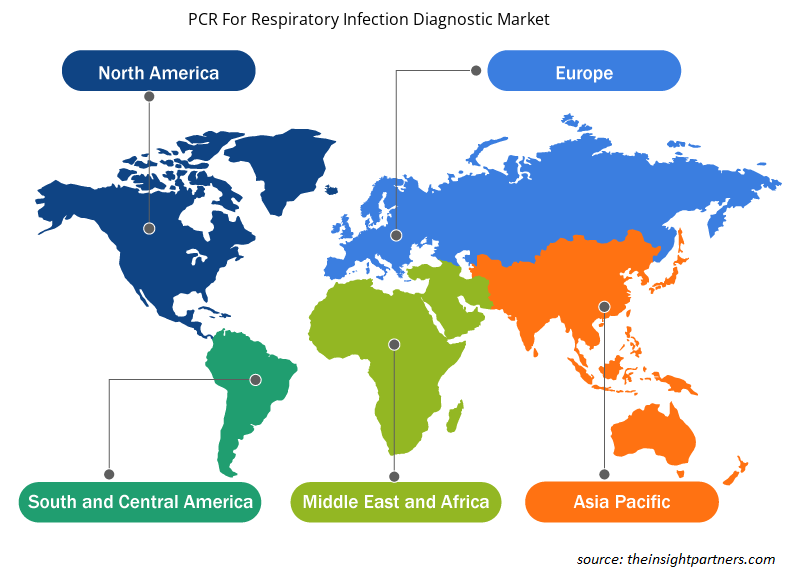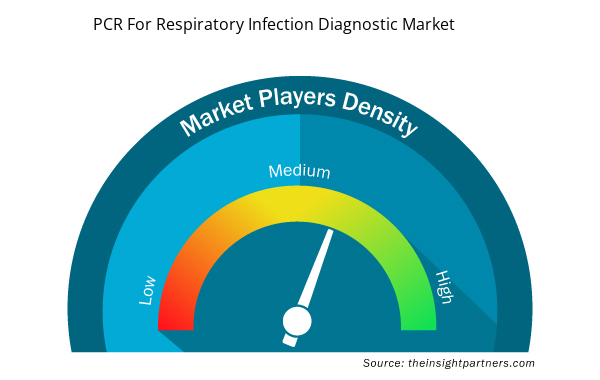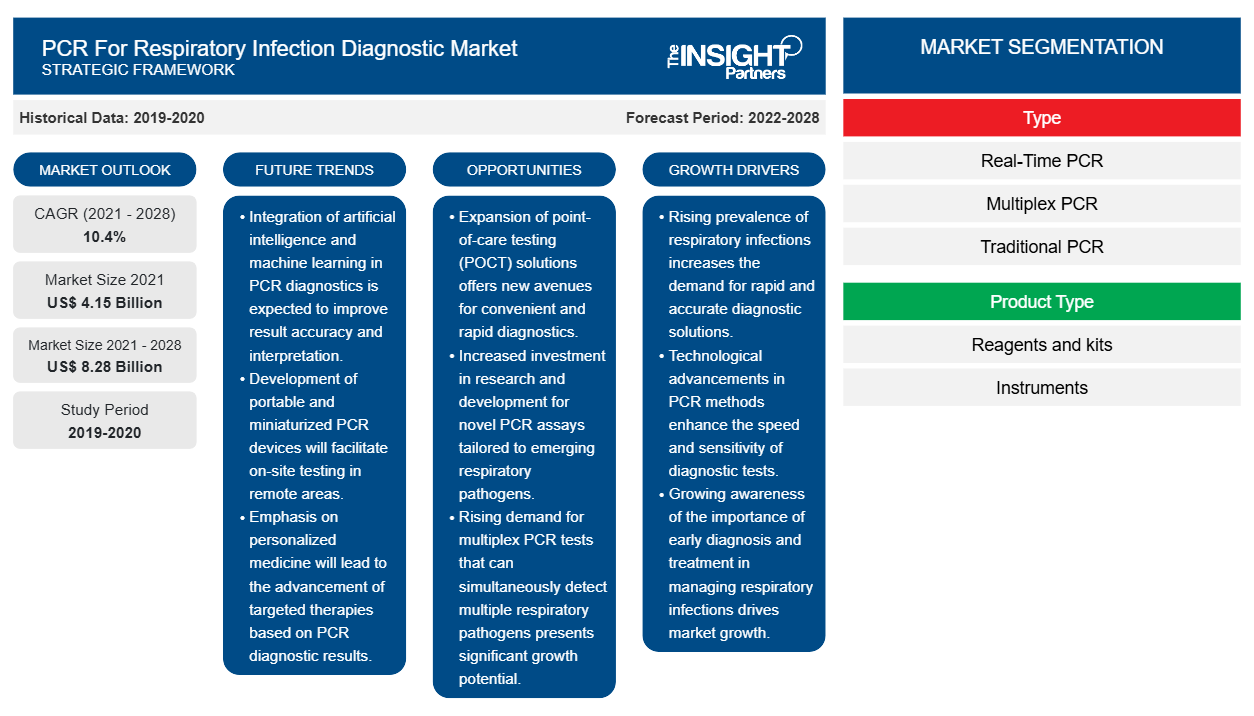Il mercato della PCR per la diagnosi delle infezioni respiratorie è stato valutato a 8.279,32 milioni di dollari entro il 2028, rispetto ai 4.146,02 milioni di dollari del 2021; si stima che crescerà a un CAGR del 10,4% dal 2021 al 2028.
La reazione a catena della polimerasi (PCR) è utilizzata per diagnosi accurate al punto di cura che aiutano a identificare e determinare rapidamente la causa delle infezioni del tratto respiratorio. Inoltre, la PCR è ampiamente preferita in contesti ospedalieri e ambulatoriali che aiutano a migliorare la crescita del mercato negli ultimi anni.
La crescita del mercato della PCR per la diagnostica delle infezioni respiratorie è attribuita a fattori quali il crescente carico di malattie respiratorie croniche (CRD), i crescenti sviluppi nei test PCR, stanno ampiamente migliorando le prestazioni dei dispositivi medici. Tuttavia, l'uso dei test PCR per varie diagnosi delle infezioni respiratorie e gli sviluppi nella tecnologia PCR utilizzata per derivarli. La disponibilità di test alternativi ostacola la crescita del mercato.
Personalizza questo report in base alle tue esigenze
Riceverai la personalizzazione gratuita di qualsiasi report, comprese parti di questo report, o analisi a livello nazionale, pacchetto dati Excel, oltre a usufruire di grandi offerte e sconti per start-up e università
- Scopri le principali tendenze di mercato in questo rapporto.Questo campione GRATUITO includerà analisi di dati che spaziano dalle tendenze di mercato alle stime e alle previsioni.
Approfondimenti di mercato
Strategie di consolidamento del mercato adottate mediante l'uso del test PCR per varie diagnosi delle infezioni respiratorie
Il test PCR è il gold standard per la rilevazione di malattie infettive respiratorie, tra cui SARS-CoV-2. Inoltre, i crescenti sviluppi nel PCR non si limitano al test COVID-19. I continui sviluppi tecnologici hanno permesso ai ricercatori di sviluppare tecniche PCR avanzate a costi ridotti e di limitarne la complessità. Si prevede che il test PCR migliorerà le sue capacità di diagnostica molecolare e rafforzerà il suo ruolo in futuro con gli sviluppi in corso di tecnologie come la microfluidica e il sequenziamento di nuova generazione . Inoltre, il test PCR è utilizzato in modo significativo in istituzioni come case di cura, strutture di assistenza cronica e ospedali, per identificare l'infezione da virus influenzale che causa focolai respiratori.
Inoltre, le infezioni respiratorie acute e croniche sono tra le principali cause di morbilità nei paesi sviluppati e in via di sviluppo a livello globale. Si stima che le malattie respiratorie acute rappresentino quasi il 75% delle morbilità acute totali a livello globale. Pertanto, diverse aziende offrono vari kit PCR in grado di rilevare la presenza di agenti patogeni che causano malattie respiratorie. Ad esempio, aziende come bioMérieux SA e altona Diagnostics GmbH forniscono un'ampia gamma di kit PCR in grado di rilevare infezioni respiratorie acute nel tratto respiratorio superiore o inferiore. Oltre alla crescente incidenza di malattie respiratorie acute e croniche, altri fattori come le condizioni ambientali e climatiche, l'inquinamento atmosferico e le scoperte di nuovi batteri, virus e agenti patogeni probabilmente fungeranno da opportunità di crescita vitali per i test PCR per la diagnosi delle infezioni respiratorie nel prossimo futuro.
Informazioni basate sul tipo
Il mercato della PCR per la diagnostica delle infezioni respiratorie, per tipo, è segmentato in PCR in tempo reale (qPCR), PCR multiplex, PCR tradizionale, PCR digitale, trascrittasi inversa (RT-PCR) e altri. Il segmento della PCR in tempo reale (qPCR) ha detenuto la quota maggiore del mercato nel 2021 e si prevede che registrerà il CAGR più elevato nel mercato durante il periodo di previsione.
Informazioni basate sul tipo di prodotto
In base al tipo di prodotto, il mercato della PCR per la diagnostica delle infezioni respiratorie è segmentato in reagenti e kit, strumenti e altri. Il segmento reagenti e kit ha detenuto la quota maggiore del mercato nel 2021 e si prevede che registrerà il CAGR più elevato del mercato durante il periodo di previsione.
Informazioni basate sul tipo di infezione
In base al tipo di infezione, il mercato della PCR per la diagnostica delle infezioni respiratorie è segmentato in infezione batterica, infezione virale e patogeni fungini e di altro tipo. Nel 2021, il segmento delle infezioni virali ha detenuto la quota maggiore del mercato e si stima che registrerà il CAGR più elevato nel mercato durante il periodo di previsione.
Informazioni basate sugli utenti finali
In base all'utente finale, il mercato della PCR per la diagnostica delle infezioni respiratorie è segmentato in ospedali, cliniche mediche, laboratori clinici, istituti accademici e di ricerca, aziende biotecnologiche e farmaceutiche e altri. Nel 2020, il segmento dei laboratori clinici ha detenuto la quota maggiore del mercato e si stima che registrerà il CAGR più elevato del mercato durante il periodo di previsione.
I lanci e le approvazioni di prodotti sono le strategie comunemente adottate dalle aziende per espandere la loro presenza globale e i loro portafogli di prodotti. Inoltre, gli operatori del mercato della ricostruzione del seno si concentrano sulla strategia di collaborazione per ampliare la loro clientela, il che, a sua volta, consente loro di mantenere il loro marchio a livello globale.
PCR per le informazioni regionali sul mercato diagnostico delle infezioni respiratorie
Le tendenze regionali e i fattori che influenzano il mercato PCR For Respiratory Infection Diagnostic durante il periodo di previsione sono stati ampiamente spiegati dagli analisti di Insight Partners. Questa sezione discute anche i segmenti e la geografia del mercato PCR For Respiratory Infection Diagnostic in Nord America, Europa, Asia Pacifico, Medio Oriente e Africa e America centrale e meridionale.

- Ottieni i dati specifici regionali per il mercato diagnostico PCR per le infezioni respiratorie
PCR per l'ambito del rapporto di mercato diagnostico sulle infezioni respiratorie
| Attributo del report | Dettagli |
|---|---|
| Dimensioni del mercato nel 2021 | 4,15 miliardi di dollari USA |
| Dimensioni del mercato entro il 2028 | 8,28 miliardi di dollari USA |
| CAGR globale (2021 - 2028) | 10,4% |
| Dati storici | 2019-2020 |
| Periodo di previsione | 2022-2028 |
| Segmenti coperti | Per tipo
|
| Regioni e Paesi coperti | America del Nord
|
| Leader di mercato e profili aziendali chiave |
|
PCR per la densità degli operatori del mercato diagnostico delle infezioni respiratorie: comprendere il suo impatto sulle dinamiche aziendali
Il mercato PCR per la diagnostica delle infezioni respiratorie sta crescendo rapidamente, spinto dalla crescente domanda degli utenti finali dovuta a fattori quali l'evoluzione delle preferenze dei consumatori, i progressi tecnologici e una maggiore consapevolezza dei benefici del prodotto. Con l'aumento della domanda, le aziende stanno ampliando le loro offerte, innovando per soddisfare le esigenze dei consumatori e capitalizzando sulle tendenze emergenti, il che alimenta ulteriormente la crescita del mercato.
La densità degli operatori di mercato si riferisce alla distribuzione di aziende o società che operano in un particolare mercato o settore. Indica quanti concorrenti (operatori di mercato) sono presenti in un dato spazio di mercato in relazione alle sue dimensioni o al valore di mercato totale.
Le principali aziende che operano nel mercato della diagnostica PCR per le infezioni respiratorie sono:
- Abate
- F. Hoffmann-La Roche AG
- Azienda
- Società a responsabilità limitata Seegene Inc.
- Diagnostica Aus
Disclaimer : le aziende elencate sopra non sono classificate secondo un ordine particolare.

- Ottieni la panoramica dei principali attori del mercato della diagnostica delle infezioni respiratorie PCR
Per tipo
- PCR in tempo reale (qPCR)
- PCR multipla
- PCR tradizionale
- PCR digitale
- Trascrittasi inversa (RT-PCR)
- Altri
Per tipo di prodotto
- Reagenti e kit
- Strumenti
- Altri
Per tipo di infezione
- Infezioni batteriche
- Bordetella
- Streptococco pneumoniae
- Stafilococco aureo
- Haemophilus influenzae
- Moraxella catarrhalis
- Micoplasma pneumoniae
- Chlamydophila pneumoniae
- Legionella
- Altri
- Infezioni virali
- Rinovirus
- Virus dell'influenza
- Sindrome respiratoria acuta grave (SARS) Virus CoV-2
- Virus respiratorio sinciziale (RSV)
- Adenovirus
- Enterovirus
- Parainfluenza
- Metapneumovirus umano (hMPV)
- Altri
- Funghi e altri patogeni
Per utente finale
- Ospedali
- Cliniche mediche
- Laboratori clinici
- Istituzioni accademiche e di ricerca
- Aziende biotecnologiche e farmaceutiche
- Altri
Per Geografia
- America del Nord
- NOI
- Canada
- Messico
- Europa
- Francia
- Germania
- Regno Unito
- Spagna
- Paesi Bassi
- Norvegia
- Italia
- Resto d'Europa
- Asia Pacifico (APAC)
- Cina
- India
- Giappone
- Australia
- Corea del Sud
- Resto dell'Asia Pacifica
- Medio Oriente e Africa (MEA)
- Arabia Saudita
- Emirati Arabi Uniti
- Sudafrica
- Resto del Medio Oriente e Africa
- America del Sud e Centro (SCAM)
- Brasile
- Argentina
- Resto del Sud e Centro America
Profili aziendali
- Abate
- F. Hoffmann-La Roche AG
- Azienda
- Società a responsabilità limitata Seegene Inc.
- Diagnostica Aus
- BD
- Laboratori Bio-Rad Inc.
- BioMérieux
- Qiagen
- Thermo Fisher Scientific Inc
- Analisi storica (2 anni), anno base, previsione (7 anni) con CAGR
- Analisi PEST e SWOT
- Valore/volume delle dimensioni del mercato - Globale, regionale, nazionale
- Industria e panorama competitivo
- Set di dati Excel



Report Coverage
Revenue forecast, Company Analysis, Industry landscape, Growth factors, and Trends

Segment Covered
This text is related
to segments covered.

Regional Scope
North America, Europe, Asia Pacific, Middle East & Africa, South & Central America

Country Scope
This text is related
to country scope.
Domande frequenti
The growth of the region is attributed to factors such as rising public–private partnerships, and increasing funding activities are widely enhancing the performance of medical devices. Moreover, presence of well-developed healthcare infrastructure and government support are some of the prominent factors propelling the market growth in Asia Pacific. In addition, the Europe is expected account for the fastest growth in the PCR for respiratory infection diagnostics market. A high demand in research, growing support from governments, continuously changing disease profiles, rising public–private partnerships, and increasing funding activities are widely enhancing the performance of medical devices growth of Europe PCR for respiratory infection diagnostics market during the forecast period.
The polymerase chain reaction (PCR) is a simple and low-cost method for amplifying small portions of DNA. Because significant amounts of a sample of DNA are necessary for molecular and genetic analyze, studies of isolated fragments of DNA are almost impossible without PCR amplification.
The growth of the market is attributed to some key driving factors such as as the increasing Burden of Chronic Respiratory Diseases (CRDs), growing developments in PCR testing, are widely enhancing the performance of medical devices. However, use of PCR testing for various respiratory infection diagnostics and developments in PCR technology being used to derive them. The availability of alternative assays hinders the market growth. In January 2020, Roche received CE Mark approval for an adenovirus test for transplant patients. It is intended to be used in conjunction with other infectious diseases tests available on their cobas systems (6800 and 8800). The majority of companies are now offering real-time polymerase chain reaction (PCR) tests for corona virus, which is contributing to the growth of the target market.Such strategic steps are also projected to drive the market growth.
Trends and growth analysis reports related to Life Sciences : READ MORE..
The List of Companies - PCR for Respiratory Infection Diagnostic Market
- Abbott
- F. Hoffmann-La Roche AG
- Hologic, Inc.
- Seegene Inc.
- AusDiagnostics
- BD
- Bio-Rad Laboratories Inc
- BioMérieux
- Qiagen
- Thermo Fisher Scientific Inc
The Insight Partners performs research in 4 major stages: Data Collection & Secondary Research, Primary Research, Data Analysis and Data Triangulation & Final Review.
- Data Collection and Secondary Research:
As a market research and consulting firm operating from a decade, we have published and advised several client across the globe. First step for any study will start with an assessment of currently available data and insights from existing reports. Further, historical and current market information is collected from Investor Presentations, Annual Reports, SEC Filings, etc., and other information related to company’s performance and market positioning are gathered from Paid Databases (Factiva, Hoovers, and Reuters) and various other publications available in public domain.
Several associations trade associates, technical forums, institutes, societies and organization are accessed to gain technical as well as market related insights through their publications such as research papers, blogs and press releases related to the studies are referred to get cues about the market. Further, white papers, journals, magazines, and other news articles published in last 3 years are scrutinized and analyzed to understand the current market trends.
- Primary Research:
The primarily interview analysis comprise of data obtained from industry participants interview and answers to survey questions gathered by in-house primary team.
For primary research, interviews are conducted with industry experts/CEOs/Marketing Managers/VPs/Subject Matter Experts from both demand and supply side to get a 360-degree view of the market. The primary team conducts several interviews based on the complexity of the markets to understand the various market trends and dynamics which makes research more credible and precise.
A typical research interview fulfils the following functions:
- Provides first-hand information on the market size, market trends, growth trends, competitive landscape, and outlook
- Validates and strengthens in-house secondary research findings
- Develops the analysis team’s expertise and market understanding
Primary research involves email interactions and telephone interviews for each market, category, segment, and sub-segment across geographies. The participants who typically take part in such a process include, but are not limited to:
- Industry participants: VPs, business development managers, market intelligence managers and national sales managers
- Outside experts: Valuation experts, research analysts and key opinion leaders specializing in the electronics and semiconductor industry.
Below is the breakup of our primary respondents by company, designation, and region:

Once we receive the confirmation from primary research sources or primary respondents, we finalize the base year market estimation and forecast the data as per the macroeconomic and microeconomic factors assessed during data collection.
- Data Analysis:
Once data is validated through both secondary as well as primary respondents, we finalize the market estimations by hypothesis formulation and factor analysis at regional and country level.
- Macro-Economic Factor Analysis:
We analyse macroeconomic indicators such the gross domestic product (GDP), increase in the demand for goods and services across industries, technological advancement, regional economic growth, governmental policies, the influence of COVID-19, PEST analysis, and other aspects. This analysis aids in setting benchmarks for various nations/regions and approximating market splits. Additionally, the general trend of the aforementioned components aid in determining the market's development possibilities.
- Country Level Data:
Various factors that are especially aligned to the country are taken into account to determine the market size for a certain area and country, including the presence of vendors, such as headquarters and offices, the country's GDP, demand patterns, and industry growth. To comprehend the market dynamics for the nation, a number of growth variables, inhibitors, application areas, and current market trends are researched. The aforementioned elements aid in determining the country's overall market's growth potential.
- Company Profile:
The “Table of Contents” is formulated by listing and analyzing more than 25 - 30 companies operating in the market ecosystem across geographies. However, we profile only 10 companies as a standard practice in our syndicate reports. These 10 companies comprise leading, emerging, and regional players. Nonetheless, our analysis is not restricted to the 10 listed companies, we also analyze other companies present in the market to develop a holistic view and understand the prevailing trends. The “Company Profiles” section in the report covers key facts, business description, products & services, financial information, SWOT analysis, and key developments. The financial information presented is extracted from the annual reports and official documents of the publicly listed companies. Upon collecting the information for the sections of respective companies, we verify them via various primary sources and then compile the data in respective company profiles. The company level information helps us in deriving the base number as well as in forecasting the market size.
- Developing Base Number:
Aggregation of sales statistics (2020-2022) and macro-economic factor, and other secondary and primary research insights are utilized to arrive at base number and related market shares for 2022. The data gaps are identified in this step and relevant market data is analyzed, collected from paid primary interviews or databases. On finalizing the base year market size, forecasts are developed on the basis of macro-economic, industry and market growth factors and company level analysis.
- Data Triangulation and Final Review:
The market findings and base year market size calculations are validated from supply as well as demand side. Demand side validations are based on macro-economic factor analysis and benchmarks for respective regions and countries. In case of supply side validations, revenues of major companies are estimated (in case not available) based on industry benchmark, approximate number of employees, product portfolio, and primary interviews revenues are gathered. Further revenue from target product/service segment is assessed to avoid overshooting of market statistics. In case of heavy deviations between supply and demand side values, all thes steps are repeated to achieve synchronization.
We follow an iterative model, wherein we share our research findings with Subject Matter Experts (SME’s) and Key Opinion Leaders (KOLs) until consensus view of the market is not formulated – this model negates any drastic deviation in the opinions of experts. Only validated and universally acceptable research findings are quoted in our reports.
We have important check points that we use to validate our research findings – which we call – data triangulation, where we validate the information, we generate from secondary sources with primary interviews and then we re-validate with our internal data bases and Subject matter experts. This comprehensive model enables us to deliver high quality, reliable data in shortest possible time.


 Ottieni un campione gratuito per questo repot
Ottieni un campione gratuito per questo repot